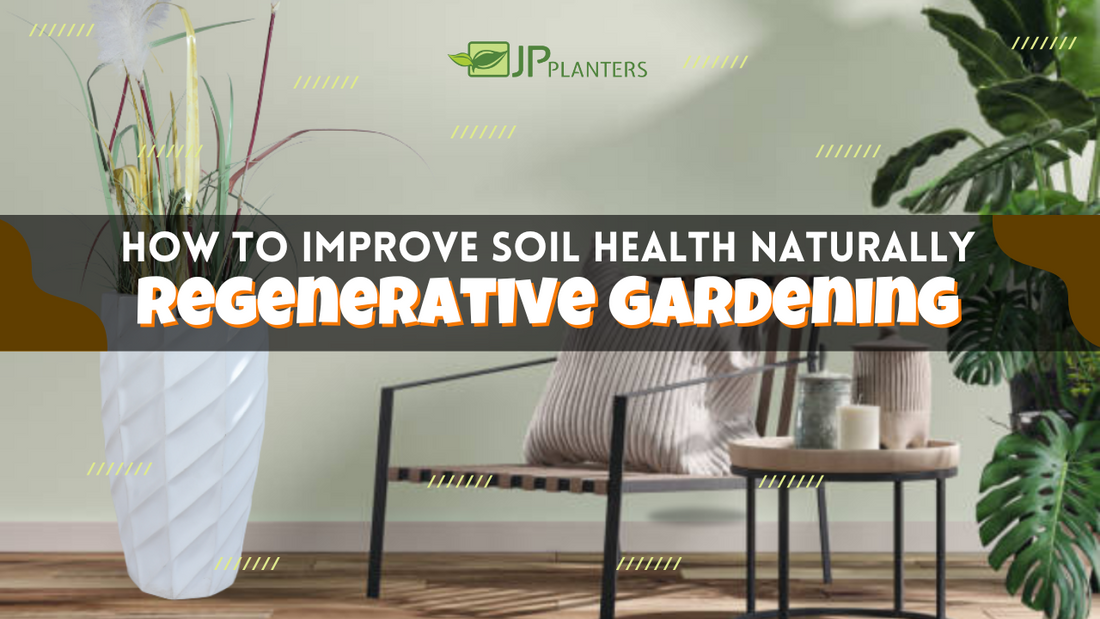
Regenerative Gardening: Natural Ways to Improve Soil Health
Share
In a world increasingly concerned about environmental sustainability, the way we garden plays a crucial role. Regenerative gardening, a holistic approach to cultivation, goes beyond simply growing plants. It focuses on revitalizing and enhancing the very foundation of our gardens – the soil. By embracing regenerative practices, we can create thriving ecosystems that not only produce abundant harvests but also contribute to a healthier planet.
Understanding the Importance of Healthy Soil
Soil is much more than just dirt. It's a complex, living ecosystem teeming with billions of microorganisms, fungi, and other organisms that are essential for plant growth. Healthy soil provides plants with the nutrients, water, and oxygen they need to flourish. It also acts as a natural filter, purifying water and preventing erosion.
Unfortunately, conventional agricultural practices, such as tilling, the use of synthetic fertilizers and pesticides, and monoculture cropping, have degraded soil health over time. These practices disrupt the delicate balance of the soil ecosystem, leading to nutrient depletion, loss of organic matter, and reduced biodiversity.
Regenerative gardening offers a powerful alternative. It's a set of practices that work in harmony with nature to rebuild soil health, enhance biodiversity, and create resilient ecosystems. By focusing on nourishing the soil, we create a foundation for healthy, productive gardens that require less intervention and are more resistant to pests and diseases.
Key Principles of Regenerative Gardening
 Regenerative gardening is built on several core principles:
Regenerative gardening is built on several core principles:
- Minimize Soil Disturbance: Tilling, while seemingly helpful, disrupts the soil structure, kills beneficial organisms, and releases carbon into the atmosphere. Regenerative gardening emphasizes no-till or minimal-till methods, preserving the soil's intricate web of life. Instead of turning the soil over, techniques like broadforking or sheet mulching can be used to aerate and prepare the soil for planting.
- Keep the Soil Covered: Bare soil is vulnerable to erosion, nutrient loss, and temperature fluctuations. Cover cropping, mulching, and allowing some "weeds" to grow (as long as they aren't overly competitive) help to protect the soil surface, retain moisture, and suppress weed growth. Mulch can be organic materials like straw, wood chips, or compost, which further enrich the soil as they decompose.
- Promote Biodiversity: A diverse range of plants, including annuals, perennials, trees, and shrubs, creates a more resilient ecosystem. Diverse plantings attract a wider variety of beneficial insects, pollinators, and microorganisms, contributing to a healthier soil food web. Companion planting, where different species are grown together for mutual benefit, is a key element of promoting biodiversity in the garden.
- Build Soil Organic Matter: Organic matter is the lifeblood of healthy soil. It improves soil structure, water retention, and nutrient availability. Composting, vermicomposting, and using cover crops are essential practices for building soil organic matter. Compost acts as a slow-release fertilizer, providing essential nutrients to plants while improving soil structure.
- Water Wisely: Regenerative gardening emphasizes water conservation. Practices like drip irrigation, rainwater harvesting, and mulching help to reduce water waste and keep the soil consistently moist. Healthy soil, rich in organic matter, also has a greater capacity to retain water, reducing the need for frequent watering.
-
Avoid Synthetic Inputs: Synthetic fertilizers and pesticides can harm beneficial organisms, pollute waterways, and disrupt the natural balance of the soil ecosystem. Regenerative gardening relies on natural methods to nourish plants and control pests, such as using compost, beneficial insects, and natural pest repellents.
Practical Techniques for Regenerative Gardening
Here are some practical techniques you can implement in your garden to embrace regenerative principles:
- Composting: Composting is the process of breaking down organic waste, such as kitchen scraps, yard waste, and paper, into a nutrient-rich soil amendment. Compost improves soil fertility, structure, and water-holding capacity.
- Vermicomposting: Vermicomposting uses worms to break down organic waste. The resulting "worm castings" are an excellent soil amendment, rich in nutrients and beneficial microorganisms.
- Cover Cropping: Cover crops are plants grown specifically to improve soil health. They can be used to add organic matter, prevent erosion, fix nitrogen, and suppress weeds. Examples include legumes like clover and vetch, as well as grains like rye and oats.
- Mulching: Mulching involves covering the soil surface with organic materials, such as straw, wood chips, or leaves. Mulch helps to retain moisture, suppress weeds, regulate soil temperature, and provide habitat for beneficial organisms.
- No-Till Gardening: No-till gardening minimizes soil disturbance, preserving the soil structure and the beneficial organisms that live within it. Techniques like sheet mulching or lasagna gardening can be used to prepare the soil for planting without tilling.
- Crop Rotation: Rotating crops helps to prevent the buildup of pests and diseases, and it also improves soil fertility by cycling nutrients.
- Companion Planting: Companion planting involves growing different species together for mutual benefit. For example, basil can repel pests from tomatoes, while beans can fix nitrogen in the soil for corn.
- Rainwater Harvesting: Collecting rainwater can help to conserve water and reduce your reliance on municipal water supplies. Rain barrels and other rainwater harvesting systems can be easily installed in your garden.
-
Building Healthy Soil Food Web: The soil food web is the complex network of organisms that live in the soil. By promoting biodiversity and adding organic matter, you can create a thriving soil food web that supports healthy plant growth.
Benefits of Regenerative Gardening
The benefits of regenerative gardening extend far beyond just a healthy garden. These practices contribute to:
- Improved Soil Health: Regenerative gardening builds soil organic matter, improves soil structure, and enhances water retention, creating a healthier environment for plant growth.
- Increased Biodiversity: By promoting a diverse range of plants and organisms, regenerative gardening creates more resilient ecosystems.
- Reduced Water Use: Healthy soil, rich in organic matter, can hold more water, reducing the need for frequent watering.
- Reduced Reliance on Synthetic Inputs: Regenerative gardening minimizes the use of synthetic fertilizers and pesticides, protecting the environment and human health.
- Increased Carbon Sequestration: Healthy soil can sequester carbon from the atmosphere, helping to mitigate climate change.
- Enhanced Food Security: By creating healthy, productive gardens, regenerative gardening can contribute to local food security.
-
A More Beautiful and Enjoyable Garden: Regenerative gardens are often more beautiful and enjoyable places to spend time, attracting a wider variety of wildlife.
Why choose JP Planters for gardening ?
Gardening is more than just planting flowers or growing vegetables—it’s about creating a thriving, sustainable green space. To achieve this, the right planters play a crucial role. JP Planters' Fiberglass Planters offer the perfect solution for gardeners looking to enhance their outdoor and indoor spaces with durability, style, and long-term sustainability.
- Superior Quality & Durability : JP Planters' fiberglass planters are crafted using high-quality materials that make them lightweight yet extremely durable. Unlike traditional ceramic or concrete planters, they are unbreakable, weather-resistant, and long-lasting, ensuring they withstand harsh outdoor conditions without cracking, chipping, or fading.
- Eco-Friendly & Sustainable Gardening : As a responsible gardener, choosing sustainable gardening materials is essential. JP Planters’ fiberglass planters are made from environmentally friendly, non-toxic materials, promoting an eco-conscious approach to gardening. Their long lifespan reduces waste, making them a better alternative to plastic and clay pots that often deteriorate quickly.
- Stylish & Versatile Designs : Whether you prefer a modern, minimalist aesthetic or a classic, elegant touch, JP Planters offers a variety of shapes, sizes, and finishes to suit any garden, balcony, or office space. These planters seamlessly blend with any environment, making them perfect for residential gardens, commercial landscapes, and indoor décor.
- Ideal for Both Indoor & Outdoor Gardening : JP Planters’ fiberglass planters are designed to cater to both indoor and outdoor gardening needs. Their water and weather resistance make them perfect for outdoor gardens, terraces, and patios, while their sleek, contemporary design enhances any indoor setting.
- Promotes Healthy Plant Growth : JP Planters' fiberglass planters provide excellent insulation, preventing temperature fluctuations that could stress plants. They also offer good drainage options, ensuring plants get the right balance of moisture, leading to healthier root systems and thriving greenery.
- Low Maintenance & Easy to Handle : Unlike heavy concrete or clay pots, JP Planters’ fiberglass planters are lightweight, making them easy to move and rearrange as needed. They require minimal maintenance, do not crack or deteriorate over time, and retain their beauty for years, making gardening effortless.
- Customization Options for Unique Spaces : For professional landscapers, interior designers, or gardening enthusiasts looking for customized solutions, JP Planters offers tailored designs, colors, and sizes to fit specific aesthetic and functional needs.
Getting Started with Regenerative Gardening
Transitioning to a regenerative gardening approach can be a gradual process. Start by implementing a few key practices, such as composting, mulching, and reducing tillage. As you gain experience, you can gradually incorporate other techniques.
Don't be afraid to experiment and learn from your mistakes. Every garden is unique, and what works for one gardener may not work for another. The most important thing is to be patient, persistent, and committed to building healthy soil.
Regenerative gardening is more than just a set of techniques. It's a philosophy that emphasizes working in harmony with nature to create thriving ecosystems. By embracing regenerative principles, we can not only grow healthy, delicious food but also contribute to a healthier planet for future generations. It's a journey of continuous learning and improvement, and the rewards are well worth the effort.



